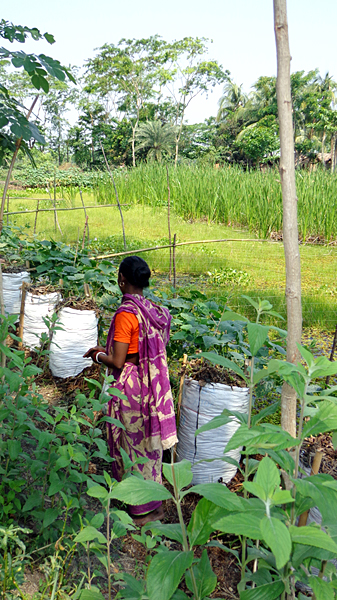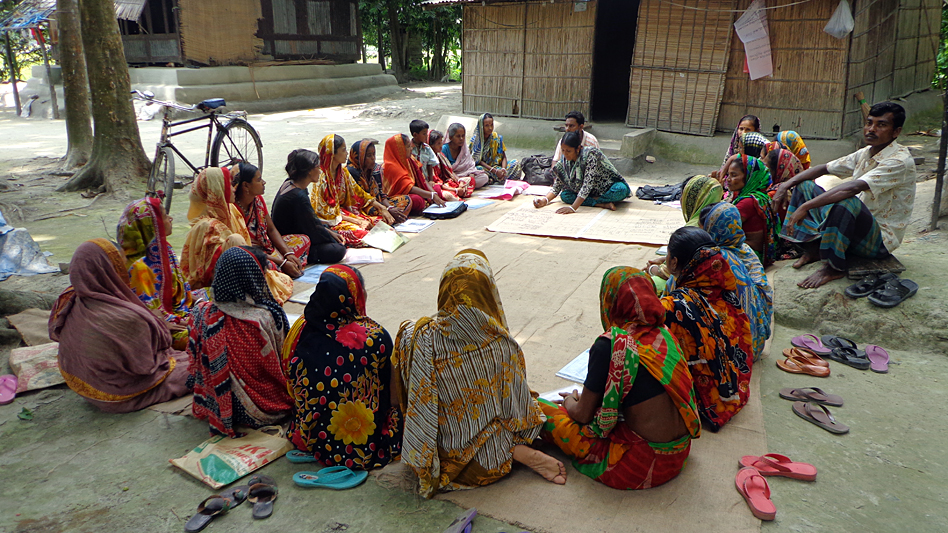Bangladeshi women find profit in new methods of vegetable cultivation and cattle rearing

Photo: Sanjiv de Silva/IWMI
Through low-cost, close-to-home farming innovations, women in rural communities in two districts of Bangladesh have increased their ability to adapt to climate change while also boosting food production and incomes.
Vegetable cultivation in jute sacks filled with soil and changes in cattle rearing practices were introduced by the international NGO iDE-Bangladesh and recently highlighted in an IWMI Water Policy Brief. Both demonstrate the economic opportunities for women limited by small homesteads and other domestic responsibilities in the midst of increasingly unpredictable floods and prolonged dry periods.
According to the policy brief, poor women are significantly more vulnerable to climate change than poor men. Living in a patriarchal society, with the obligations of caring for children and other family members, places additional restrictions on women’s ability to become more productive, and to adapt to climate change. The two case studies on sack vegetable cultivation in the Barisal District of south-central Bangladesh and modern cattle rearing in the Kurigram District in the north-east, exemplify activities which allow women to manage multiple roles and better secure food and income for the household.
Both districts have experienced increasing climatic variations, disrupting agriculture and livelihoods. Over the last decade, rainfall has become less consistent but more intense; annual floods have become unpredictable, and the need to irrigate rice and wheat has risen, making production more expensive.
Sack vegetable cultivation and cattle rearing are less dependent on irrigation and, since both sacks and animals can be moved at short notice, they can be protected from floods. These two practices are also suitable for women to carry out in small spaces on or near their homesteads, allowing them to manage other responsibilities such as childrearing and cooking. Reducing this risk has a significant impact on women and their families, according to the policy brief.
In many communities in the Barisal District, women have benefited from growing vegetables such as cauliflower, chili and several gourd varieties in inexpensive jute sacks filled with soil and compost. The sacks can be easily irrigated from nearby water sources, and consequently, do not consume much of the women’s time. However, the most valuable characteristic of the sacks is that their mobility allows women to provide household food even when fields (mainly the men’s domain) are flooded.
Before participating in the project, most of these women were dependent on their husbands’ incomes or seasonal work as farm laborers. By adopting low-cost technologies to grow vegetables and participating in a small producers group, women have ensured more food for the household and diversified their income. For example, Hasina Begum was able to lease more land and expand her vegetable production, selling to local markets and generating a higher profit. She is now able to afford three meals a day and pay for home repairs.
Women in the Kurigram District are benefiting from green fodder production and modern cattle rearing practices. Green fodder – livestock feed from improved green grass – is highly nutritious and more easily digestible for cattle, spurring healthy weight gain and more milk production. In places where quality and quantity of pasture is low, this type of fast-growing crop is a steady source of food for livestock. By producing their own fodder, the women are able to reduce feed costs and sell the excess in nearby markets.
Investment in chopping machines and troughs has also helped improve cattle health and save time for women. The chopping machines quickly break long shafts of grass into a more easily digestible size for the cattle. With these technologies the fodder is kept off the ground to prevent spoilage and women can feed the cattle more efficiently.

By forming small producers groups, the women receive training on selecting better breeds of cattle and high-quality fodder seeds. They also learn about small-scale irrigation, storage practices (such as making silage with locally available materials) to protect fodder during the rainy season, and business plan development. Through workshops and meetings with veterinarians, they gain more knowledge about vaccinations, de-worming, weight measurement, feeding and other practices to raise healthier cattle, which grow at a faster rate and can be sold at higher prices within shorter period of time (3-4 month/cycle). Annual household incomes have increased six-fold because of these innovations.
As demonstrated in both case studies, participation in small producer groups was also found to be key in supporting women to contribute more to decision-making. Husbands increasingly valued and respected the women as participation in the group brought benefits to the household and community.
Shamin Khatun, a mother-of-two whose husband leaves the village for seasonal work, said, “[The other women of the Kurigram District and I] are enjoying the opportunities to take charge of our family’s wellbeing and be part of these social groups.”
Many women reported that they were more active in determining household expenditure and investments, often allotting more money for medicine and educational materials for their children than before. Some are now better able to obtain credit. For example, a group in Barisal collectively leased a fishpond, which is traditionally a male-dominated activity.
According to the policy brief, these two case studies once again highlight the need to consider gender in climate change interventions and poverty reduction.
[pullquote type=”pullquote3″ content=””In rural Bangladesh and other developing countries, men and women work within different geographical spaces, which offer different resources and productive possibilities. By being gender-sensitive, both policy and interventions can optimize the production capacities of these spaces. Not doing so risks leaving women behind and losing their contributions to climate change adaptation and development.” – Sanjiv De Silva, IWMI researcher.” quote_icon=”no” align=”center” textcolor=”#22a022″]”In rural Bangladesh and other developing countries, men and women work within different geographical spaces, which offer different resources and productive possibilities. By being gender-sensitive, both policy and interventions can optimize the production capacities of these spaces. Not doing so risks leaving women behind and losing their contributions to climate change adaptation and development.” – Sanjiv De Silva, IWMI researcher.[/pullquote]
[hr top=”yes”/]
Read the policy brief:
International Water Management Institute (IWMI). 2014. Promoting productive gendered spaces for adapting to climatic stress: two case studies from rural Bangladesh. Colombo, Sri Lanka: International Water Management Institute (IWMI). 4p. (IWMI Water Policy Brief 36). [doi: 10.5337/2014.234]
[hr-border top=”no”/]
International Development Enterprises (iDE) is an international non-governmental, non-profit organization with over 30 years of experience in designing and delivering market based anti poverty programs.
www.ideorg.org | www.ide-bangladesh.org
[hr top=”yes”/]
For more information on growing food where space is limited:
- Jinapala, K.; Ariyaratne, B. Ranjith. 2009. Partnerships in action: establishing movable and vertical vegetable gardens for internally displaced persons in the north. Water Matters: news of IWMI research in Sri Lanka, 4:7 (http://www.iwmi.cgiar.org/wp-content/themes/ultimate/pdf/Water_Matters-Issue-4.pdf)
- Manual of Low/No-Space Agriculture -cum- Family Business Gardens by Dr. Thilak T. Ranasinghe (http://www.sundaytimes.lk/100425/Plus/plus_25.html)
- Vertical gardens: http://www.sswm.info/category/implementation-tools/water-use/hardware/reuse-agriculture/vertical-gardens
- Family business gardens: agricultural options in remodeling & modernizing tsunami devastated township in Sri Lanka (http://www.scribd.com/doc/50851303/Urban-Agriculture-inSri-Lanka#scribd)


